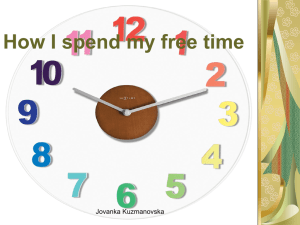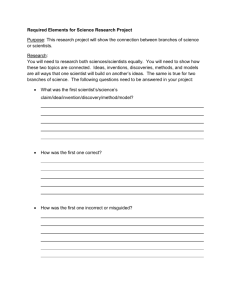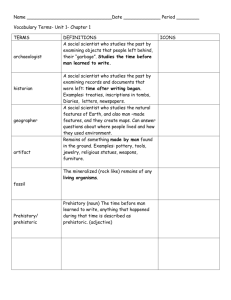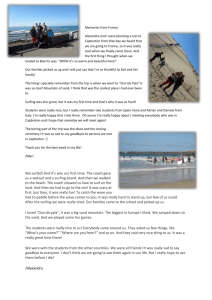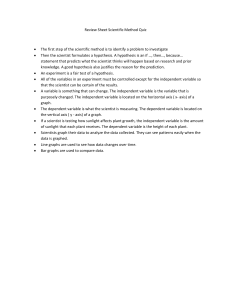E5 instructional skill breakdown *
advertisement
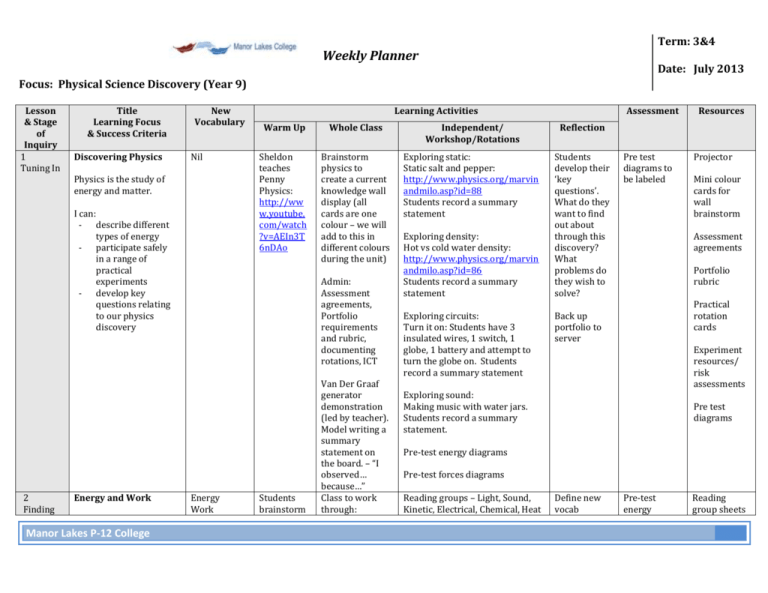
Term: 3&4 Weekly Planner Date: July 2013 Focus: Physical Science Discovery (Year 9) Lesson & Stage of Inquiry 1 Tuning In Title Learning Focus & Success Criteria Discovering Physics New Vocabulary Nil Physics is the study of energy and matter. I can: - describe different types of energy - participate safely in a range of practical experiments - develop key questions relating to our physics discovery 2 Finding Energy and Work Manor Lakes P-12 College Learning Activities Warm Up Whole Class Independent/ Workshop/Rotations Reflection Sheldon teaches Penny Physics: http://ww w.youtube. com/watch ?v=AEIn3T 6nDAo Brainstorm physics to create a current knowledge wall display (all cards are one colour – we will add to this in different colours during the unit) Exploring static: Static salt and pepper: http://www.physics.org/marvin andmilo.asp?id=88 Students record a summary statement Students develop their ‘key questions’. What do they want to find out about through this discovery? What problems do they wish to solve? Admin: Assessment agreements, Portfolio requirements and rubric, documenting rotations, ICT Energy Work Assessment Students brainstorm Van Der Graaf generator demonstration (led by teacher). Model writing a summary statement on the board. – “I observed… because…” Class to work through: Exploring density: Hot vs cold water density: http://www.physics.org/marvin andmilo.asp?id=86 Students record a summary statement Exploring circuits: Turn it on: Students have 3 insulated wires, 1 switch, 1 globe, 1 battery and attempt to turn the globe on. Students record a summary statement Pre test diagrams to be labeled Resources Projector Mini colour cards for wall brainstorm Assessment agreements Portfolio rubric Practical rotation cards Back up portfolio to server Experiment resources/ risk assessments Exploring sound: Making music with water jars. Students record a summary statement. Pre test diagrams Pre-test energy diagrams Pre-test forces diagrams Reading groups – Light, Sound, Kinetic, Electrical, Chemical, Heat Define new vocab Pre-test energy Reading group sheets Out/ Sorting out A Energy exists in many different forms and is used to do work. I can: - describe different types of energy - explain what is meant by ‘work’ - describe the difference between kinetic and potential energy 3 Energy Transfer and Transformation Potential Kinetic Thermal Chemical Electrical Sound Light Transfer Transform Energy cannot be created or destroyed. I can: - explain how energy is transferred and transformed - give examples of energy transference and transformation 4 Motion and forces A force is a pull, push or twist and can be described as contact or Mass Force Weight Gravity Friction types of energy Interactive: http://ww w.childrens university. mancheste r.ac.uk/inte ractives/sc ience/ener gy/what-isenergy/ Introductio n to forces: http://ww w.bbc.co.uk /bitesize/k http://www.esc hooltoday.com/ energy/kindsof-energy/allaboutenergy.html Complete picture activity together Define transfer and transform. Fill in vocab column together Backtracking to identify energy transfer/ transformations. Elyse kicks the ball across the classroom – backtrack the energy… Discuss contact (touch, friction, buoyancy) and non-contact forces (gravity, Energy. Groups to summarise their type of energy and give an example Guided discussion – Students to present their summaries to the whole group. Listeners to fill in summary table and record one question. Group to attempt to answer question. Teacher to model for potential energy Kinetic Energy vs Potential Energy: Students create their own ‘tennis ball roller coaster’ using prompt sheet. Teams of 34 students. Prize for winning design. Students to explain existence of/increase/decrease in kinetic and potential energy throughout their design Kinetic transfer: bouncing balls experiment Transformation chemical to thermal: Rusty Wool Transformation kinetic to thermal: Shaking Sand experiment Students read the explanation cards from each station and complete three summaries. diagrams Re-visit pretest energy diagrams and add information ‘Types of energy’ summary table Tennis balls, cardboard, sticky tape, glue, stapler, blue tack, mini spades etc. Prize for winning group Fill in two Frayer charts for Energy Transfer and Energy Transformati on. Collect workbooks/ portfolios ASSEMBLY SESSION 4 (25 mins) Friction: Gripping Rice (Surfing Scientist #1 pg. 42) Vocab statements Buoyancy: Cartesian Diver (Surfing Scientist #2 pg. 62) Assess a peer’s Frayer charts Portfolio feedback – use these to display strong and weak examples of students record keeping Pre-test energy diagrams Experiment resources/ risk assessments Practical rotation cards Challenge reading sheets Practical rotation cards Experiment Term: 3&4 Weekly Planner Date: July 2013 Focus: Physical Science Discovery (Year 9) non-contact. Buoyancy I can: - give examples of contact and noncontact forces - describe the difference between mass and weight 5 Newton’s laws 1 Inertia Momentum Three key laws describe the properties of motion. I can: - explain each of Newton’s three laws - give examples of each of Newton’s laws 6 Electrical energy Electricity is the movement of electrons through conductors and Manor Lakes P-12 College Charge Conductors Insulators Resistors Amperes s3/science /energy_el ectricity_fo rces/forces /activity/ magnetic, electric), the difference between mass and weight Watch 3 Simpsons videos and describe how last lesson’s work on motion and forces applies. Explicit teaching of Newton’s 3 Laws using: http://science.d iscovery.com/ga mes-andinteractives/ne wtons-laws-ofmotioninteractive.htm Students record how many times they have used Introduction to electricity, batteries and conductors: http://www.yo Gravity: Calculate your weight on the moon. Feedback questions: What is the task sheet asking you to do? What processes do you need to use to apply the weight formula? Have you had a go at the challenge task? What strategy did you use to understand this? Newton’s First and Second Law: Cup’s Away (Scientists through the ages pg. 99) Newton’s Third Law: Pop-ARocket (Surfing Scientist #2 pg. 58) Students create a short video explaining one or more of newton’s laws. Feedback questions: What is the video task asking you to do? What is your action plan for creating your video? How else might you present your video? How could you make the best use of the session time within the team? Generating electricity: http://www.bbc.co.uk/schools/g csebitesize/science/aqa/mains/ generatingelectricityact.shtml workbook for ongoing portfolio feedback Physics quiz: http://scienc e.discovery.c om/gamesandinteractives/ newtonslaws-ofmotioninteractive.ht m resources/ risk assessments Pre-test forces diagrams Post test diagrams Practical rotation cards Experiment resources/ risk assessments Re-visit pretest forces diagrams and re-label Review practical report cheat sheet Lemon Battery Practical Report Projector Experiment resources/ risk flowing electrons are called current. 7 I can: - explain the connection between electrons and electricity - safely create a lemon battery - describe the difference between conductors and insulators Physics in Sport Voltage (Ohms law) Nil Our knowledge of physics can be related to our understanding of rugby. electrical energy in the past 24 hours utube.com/watc h?v=EJeAuQ7pk pc Lemon batteries: http://vimeo.com/60750031 Key questions – would this work if we used materials other than zinc and copper? Explain conductor vs insulators Write conclusion for lemon battery experiment Brainstorm : what might physics have to do with sport? Introduce Socratic Circles Groups read three key articles in small groups (rotating the articles) Science Alive 5: Types of Forces pg192-3; Energy in Sport pg204-5; Science Alive 6: Sir Isaac Newton’s next two laws pg.274. Reflect on the Socratic circle: record two things we did well/were useful and two things we need to improve on Lemon Battery Practical report due Socratic circle preparation sheet Recording of Socratic Circles and student input Articles Reflect on Socratic circle: what difference did it make; our being more confident with the Recording of Socratic Circles and student input Socratic circle preparation sheet I can: - explain each of Newton’s three laws - participate in a Socratic circle discussion Students fill in the Socratic Circles Preparation Sheet for the discussion point: The study of Physics is completely useless when coaching a Rugby team. assessment Practical report cheat sheet Run Socratic Circle with class. ASSEMBLY SESSION 4 8 Newton’s laws 2 Three key laws describe the properties of motion. I can: - explain each of Newton’s three laws Nil Review last week’s Socratic circles: share reflections with each other. Give students title and abstract of each of the six technology articles. Discuss the benefits of being confident with the Students select one or more technology articles to read and fill in the Socratic Circles preparation sheet for the discussion point: Technology has has no real benefits for mankind. Run Socratic Circle with class. Technology Articles Poster paper Term: 3&4 Weekly Planner Date: July 2013 Focus: Physical Science Discovery (Year 9) - 9 give examples of each of Newton’s laws Electrical circuits Electricity requires a complete path in order to flow. This path is called a circuit. I can: - build a working electrical circuit - describe the symbols used to demonstrate an electrical circuit Manor Lakes P-12 College content. Session 3: Review Newton’s 3 Laws using: http://science.d iscovery.com/ga mes-andinteractives/ne wtons-laws-ofmotioninteractive.htm Current Series Parallel Battery Ammeter Voltmeter Switch AGL AD: Students watch and record the renewable and nonrenewable energy types showcased: http://ww w.youtube. com/watch ?v=Dsju9M 8vIzo Introduction to circuits: http://www.bbc .co.uk/bitesize/ ks3/science/en ergy_electricity_ forces/electric_c urrent_voltage/ activity/ Extension task – complete ‘test’ on current and voltage (link is below the interactive) content? Session 3: Students work in set groups: Create a poster describing to the class what each of the laws are: 1st law: Connor, Mikhail, Chloe 2nd law: Jay, Jayden, Dylan N, Kuros 3rd law: Phoebe, Joe, Callum, Forest Extension groups: students physically demonstrate what one of the laws are by giving a physical example and their explanation for the class: 1st law: Michael, Ashton, Nayshen 2nd law: Dion, Callum D, Nitesh 3rd law: Daniel, Kayley, Leander Make circuits online: http://www.bbc.co.uk/schools/s cienceclips/ages/10_11/changin g_circuits.shtml Symbol and definition cut and paste activity Build a circuit challenge – parallel and series circuits including switches. Draw a diagram of your circuit with correct symbols and legend Extension task – electrical pathways challenge activity and textas Session 3: Share the posters and physical demonstrati ons Where might you find series circuits? Where might you find parallel circuits? Build a circuit challenge and associated symbol drawing Experiment resources/ risk assessments Symbol and definition cut and paste activity 10 Drawing Electrical Circuits Nil Electricity requires a complete path in order to flow. This path is called a circuit. 11 Elyse Absent I can: - build a working electrical circuit - accurately draw an electrical circuit using appropriate symbols - describe and demonstrate the difference between a series and a parallel circuit - use a multimeter accurately to measure current and voltage Electricity and Magnetism When an electric current flows through a coil of wire it creates a magnetic field. This functionality is used to create many devices. I can: - build a working electromagnet describe the effect of current strength and Review forces and motion pre-test diagrams. Students add informatio n to these. Use a student drawn circuit from last week. Re-draw it as a class using correct symbols. Students have a pack of random electrical resources. Have twenty minutes to create the most interesting circuit they can. Must include a switch and a globe. Students draw their circuits using appropriate symbols (use whiteboards so that it’s collaborative). Students read about using the multimeter (explicit teaching at front of class). Students return to their circuit and practise taking readings at different parts of the circuit. What do they observe about voltage and current? Electromagn et Coils Magnetic field Introducti on to waves: http://ww w.bbc.co.u k/schools/ gcsebitesiz e/science/ aqa/waves /generalw avesact.sht ml Guided class reading of Science Alive 6 pg. 220-223 Extension – students can work through Gwen’s electrical circuit challenge box. Sound waves: Mobile Phone Disco (Surfing Scientist #2 pg. 68) Electromagnet interactive: http://www.harcourtschool.com /activity/electromagnets/ Electromagnetic gadgets – students read ‘how it works cards’ (taken from Science Alive 6 pg. 220-225). Challenge – can they hypothesis how a loud speaker would work? Write their group hypothesis in a paragraph in their books. Brainstorm what we now know about physics to update our wall display (use different colour to beginning unit colour) Build a circuit challenge and associated symbol drawing Knowledge cards Miniwhiteboards Experiment resources/ risk assessments Mini coloured cards for brainstorm wall Back up portfolio to server Students answer prompt question in their books: what does electricity have to do with magnetism? Post test diagrams Written hypothesis re: how speakers work Practical rotation cards Experiment resources/ risk assessments Term: 3&4 Weekly Planner Date: July 2013 Focus: Physical Science Discovery (Year 9) - 12 Elyse absent number of coils on the strength of the magnetic field created explain how an everyday gadget works Electromagnetic Energy Visible light is a form of electromagnetic energy that that we can see. Electromagnetic energy travels in waves and can be reflected and refracted. I can: - - describe the electromagnetic spectrum explain what is meant by wavelength and frequency explain how light can be reflected and refracted (bent) Manor Lakes P-12 College Make an electromagnet: http://www.sciencebob.com/ex periments/electromagnet.php Spectrum Rays Frequency Wavelength Reflection Refraction Fibre Optics Electromag -netic spectrum: http://ww w.bbc.co.u k/schools/ gcsebitesiz e/science/ aqa/waves /soundand lightact.sht ml Guided class reading of Science Alive 6 pg. 238-239 and 242 Gwen demonstration of: Refraction of light through glass and oil: http://www.ph ysics.org/marvi nandmilo.asp?id =89 Extension: Ashton and Billy to create a working alarm clock using Gwen’s electrical circuit challenge box. Explore electromagnetic spectrum wavelengths and frequencies at: http://earthguide.ucsd.edu/eoc/ special_topics/teach/sp_climate_ change/p_emspectrum_interacti ve.html Students record their observations: What do you notice about the frequency and wavelength of low energy electromagnetic waves such as microwaves as opposed to high energy waves like gamma rays? Light Bender (Surfing Scientist #2 pg. 48) Students read Science Alive 6 pg. 256-257 and answer questions 1-5 plus any one of questions 610 (free choice) Additional options: Light boxes: make a rainbow challenge using prisms Weird rainbows: Gwen demonstrati on of : Fibre Optic Water (Surfing Scientist #2 pg. 44) Questions responses Practical rotation cards Experiment resources/ risk assessments Mini colour cards for wall brainstorm 13 Going Further Investig ation A Going further session 1 Nil Physical principals can be used to explain the function of many everyday occurrences. Teacher demonstrat ion: Flying Tea Bags (Surfing Scientist #1 pg. 52) Introduce assessment task. Students fill in ‘high’ column of rubric as a group. I can apply my understanding of energy and forces in my investigation of an everyday event. I have produced a presentation to teach my peers. 14 Going Further Going further session 2 Physical principals can Nil Verbal collage: students Review task rubric with whole class to http://www.physics.org/articlequestions.asp?id=58 What is a mirage? http://www.physics.org/articlequestions.asp?id=45 Why is the sky blue? How do fridges work? How do mobile phones work? How does GPS work? How does an MRI work? Why have full body polyurethane swimsuits been banned in swimming? Why do people argue that amputee runner Oscar Pistorus has an unfair advantage? How do early warning tsunami systems work? How do speakers work? What causes the earth’s magnetic field? How do 3D films work? How do hybrid cars work? Why are vicroads installing new cable barriers rather than steel barriers on our roadways? Why do cars have airbags? Feedback questions: - read the question to me - what is it asking you? - What do you need to do to answer it? - Get the answer - Does the answer make sense? Students work independently on their presentations Personal goal setting: Students record what they need to complete at home in readiness for next week. Investigation task Post-its Practical demonstrati on resources Students submit their key question of choice. Personal goal setting: Students Investigatio n task sheet and rubric. Projector Investigation task Term: 3&4 Weekly Planner Date: July 2013 Focus: Physical Science Discovery (Year 9) Investig ation A be used to explain the function of many everyday occurrences. I can apply my understanding of energy and forces in my investigation of an everyday event. I have produced a presentation to teach my peers. 15 Going Further Investig ation A Finding Out/ Sorting Out B Sharing knowledge Nil say their question aloud to get a sense of what others are investigati ng and who they might collaborat e with. Nil Physical principals can be used to explain the function of many everyday occurrences. determine priorities for the session ASSEMBLY SESSION 3 record what they need to complete at home in readiness for next week’s presentation s Discuss student rubrics for peer assessment and create groupings. Students share their ‘going further’ presentations Brainstorm what we now know about physics to update our wall display (use different colour to beginning and mid unit colour) I can apply my understanding of energy and forces in my investigation of an everyday event. I have produced a presentation to teach my peers. The Power of Water Hydroelectri city Siphon Buoyancy ? ? Water density experiment: http://www.physics.org/marvin andmilo.asp?id=90 Hydrodynamics: Hero’s fountain (Surfing Scientist #2 pg. 37) Manor Lakes P-12 College Investigation task due Portfolio due Practical rotation cards Student rubrics for peer assessments Experiment resources/ risk assessments Mini colour cards for wall brainstorm Density: DIY Lava Lamp (Surfing Scientist #2 pg. 54) Straw Siphon (Surfing Scientist #2 pg. 66) Density Layers (Surfing Scientist #1 pg. 12) Density: Orange Life Jacket (Surfing Scientist #1 pg. 74) 16 The Power of Air Air pressure Wind power Aerodynamic s Displacement – bath experiment by Archimedes Air pressure in our homes: http://www.physics.org/feature detail.asp?id=78 Air resistance: http://www.physics.org/marvin andmilo.asp?id=74 Aerodynamics: O-Wing Glider (Surfing Scientist #2 pg. 24) Aerodynamics: Hovercopter (Surfing Scientist #2 pg. 30) Air pressure: Magic Bottle (Surfing Scientist #2 pg. 40) Air pressure: Inflation Impossible (Surfing Scientist #2 pg. 42) Air pressure: Straw Pipette (Surfing Scientist #1 pg. 10) Airflow over wings: Sticky Stream (Surfing Scientist #1 pg. Practical rotation cards Experiment resources/ risk assessments Weekly Planner Term: 3&4 Date: July 2013 Focus: Physical Science Discovery (Year 9) 17 Space 38) Vacuum and atmospheric pressure: Robo-Manga Head (Surfing Scientist #2 pg. 22) Black hole Vacuum Big bang Expansion Contraction Orbit Gravitational Practical rotation cards Experiment resources/ risk assessments 18 Weird and Wonderful Nanotechnol ogy Teacher demonstrat ion: Water absorbs heat in flaming balloons http://ww w.physics. org/marvi nandmilo. asp?id=82 Why do we observe this? Nanotechnology and electromagnets to fight cancer: http://www.physics.org/feature detail.asp?id=44 Nanotechnology: http://www.physics.org/feature detail.asp?id=57 Sunscreen and UV radiation: http://www.physics.org/articlequestions.asp?id=46 Radiation and phone use: http://www.physics.org/articlequestions.asp?id=84 Could we ever go back in time? http://www.physics.org/articlequestions.asp?id=48 Experiment resources/ risk assessments 19 Structural Strength Cylinders Density Students undertake one challenge game: http://ww w.physicsg ames.net/ Centre of gravity: Acrobatic Cutlery (Surfing Scientist #2 pg. 12) Practical rotation cards Centre of gravity: Uncanny CanCan (Surfing Scientist #1 pg. 32) Experiment resources/ risk assessments Cylinders: Spear a Spud (Surfing Manor Lakes P-12 College Scientist #1 pg. 28) Cylinders: Super Can (Surfing Scientist #1 pg. 30) 20 Going Further Investig ation B 21 Reflectin g Corrugated Paper (Surfing Scientist #1 pg. 80) Popstick bridge challenge Structures Investigation Physical Science Other potential experiments: Friction: CD Hovercraft (Surfing Scientist #2 pg. 56) Friction: Inseparable books (Surfing Scientist #1 pg. 40) Portfolio learning walk to review experiment s and key learning activities Students complete subject/ teacher feedback survey Research global science projects – students explore which projects would need a physicist: http://www.futuremorph.org/w pcontent/uploads/games/globepl otter/index.html Maths and science career research: http://www.futuremorph.org/w pcontent/uploads/games/science andmaths/index.html#/intro Re-visit pretest energy diagrams and re-label Finishing year 9 science with a bang: Sugar can go bang (Expose, Excite, Ignite pg. 85) Experiment resources/ risk assessments
